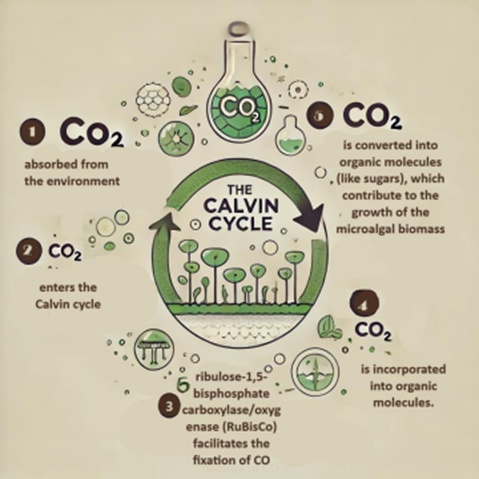Recent Development for Sustainable Carbon Capture with Microalgae
Recent Development for Sustainable Carbon Capture with Microalgae
By Aanika Roshni
The urgent need to reduce CO₂ emissions has made researchers investigate novel carbon capture techniques. Among these methods, biochemical engineering presents an inventive solution via microalgae-based carbon capture and utilization (CCU). Although many recent solutions exist, one particularly noteworthy approach is the application of microalgae in carbon capture and utilization (CCU). Microalgae naturally take up CO2 from the environment through photosynthesis and function as small biofactories, converting this greenhouse gas into a variety of valuable products. However, the challenge remains to optimize these processes effectively.
The bio-CCU process is not only eco-friendly but also versatile. The capacity of capturing CO2 of microalgae is exceptionally efficient. They utilize sunlight to transform CO₂ into lipids, proteins, carbohydrates and pigments, each of which possess significant market potential. For instance, lipids derived from algae can be converted into biofuels, while proteins and carbohydrates function as animal feed and in nutraceuticals. These biofuels are compatible with existing engines and infrastructure, making them a practical renewable energy source. However, proteins from microalgae serve as high-nutrient feed for livestock, aquaculture and even as human food supplements, which are ideal for plant-based diets [1]. Although algal pigments are sought after in cosmetics and pharmaceuticals, this is primarily due to their antioxidant properties. Unlike conventional carbon storage methods, which often risk CO₂ leaks, microalgae-based systems safely trap and convert CO₂, creating a continuous cycle of capture and usage. Additionally, microalgae can be cultivated using industrial waste streams, which adds another layer of sustainability.[2]

Microalgae-based carbon capture is advancing with methods like genetic engineering and nanotechnology. Genetic modifications enhance efficiency of key enzymes (e.g.,) RuBisCo, which drives carbon fixation in microalgae. By using carbonic anhydrase (CA), scientists increase CO₂ assimilation, because CA accelerates the conversion of CO₂ into usable forms. Furthermore, engineered strains can thrive in high CO₂ concentrations, improving biomass yield and bio fixation potential in industrial applications. Nanomaterial integration represents another breakthrough in microalgal carbon capture. Materials such as graphene oxide and metal-organic frameworks enhance diffusion and dissolution of CO₂ in culture medium. For instance, CO₂-absorbing nanomaterials promote photosynthesis by ensuring sustained CO₂ availability, which boosts biomass production. However, light-scattering nanoparticles optimize light absorption in
photobioreactors, thus elevating photosynthetic efficiency. Overall, these innovations make microalgae an increasingly viable solution for large-scale carbon capture.[3]
In conclusion, microalgae-based carbon capture presents transformative solutions for reducing CO₂ emissions while creating high-value bioproducts. By harnessing genetic engineering and nanotechnology, the efficiency in bio-fixation and bioproduct conversion using microalgae is continuously enhanced; this makes them a viable component of the green economy. However, as industries shift towards sustainability, microalgae offer a pathway not only to achieve carbon neutrality but also to generate renewable resources, fostering a circular economy. This innovative approach emphasizes the vital role of biochemical engineering in shaping a sustainable, low-carbon future, driving both environmental and economic resilience. Although challenges remain, the potential benefits are substantial.
References
[1] T. Yu et al., “Carbon Capture and Resource Utilization by Algal–Bacterial Consortium in Wastewater Treatment: A Mini-Review,” Water 2024, Vol. 16, Page 2197, vol. 16, no. 15, p. 2197, Aug. 2024, doi: 10.3390/W16152197.
[2] A. H. Alami, S. Alasad, M. Ali, and M. Alshamsi, “Investigating algae for CO2 capture and accumulation and simultaneous production of biomass for biodiesel production,” Science of The Total Environment, vol. 759, p. 143529, Mar. 2021, doi: 10.1016/J.SCITOTENV.2020.143529.
[3] S. Li, X. Li, and S. H. Ho, “How to enhance carbon capture by evolution of microalgal photosynthesis?,” Sep Purif Technol, vol. 291, p. 120951, Jun. 2022, doi: 10.1016/J.SEPPUR.2022.120951.


